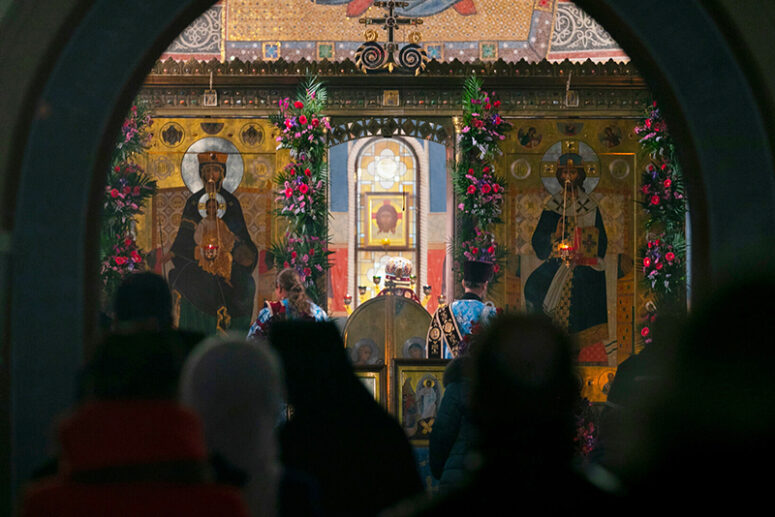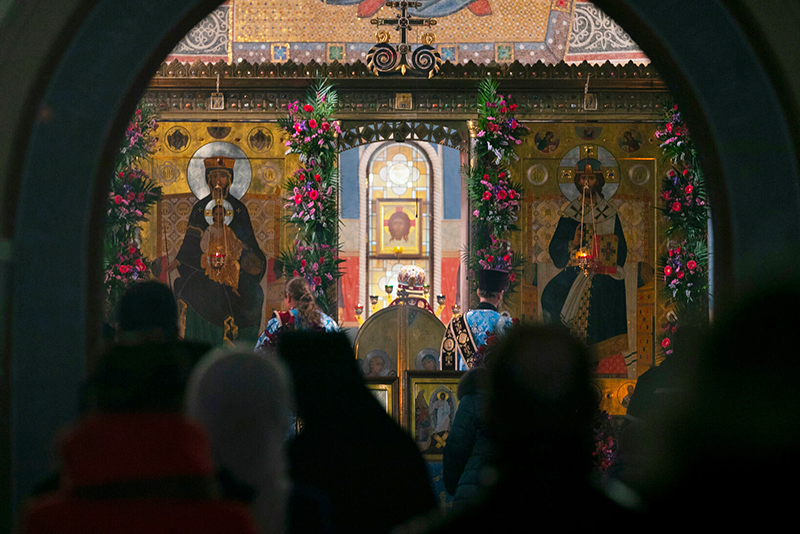
The altar barrier called the iconostasis separates the temple from its Holy of Holies, where the credence table and the bishop’s throne are located. It also serves as the hallmark of any Orthodox church. The Royal or, rather, the Holy Doors form the central element of the iconostasis. What is the origin of the Holy Doors? What symbolism do they carry and what is their function during worship?
The Origin
As we know from Scripture, the Early Church did not celebrate its divine services in dedicated temples. Instead, Christians gathered in private homes and catacombs to “break” the Bread of Life on the Lord’s Day. A designated place, usually in the form of a table situated on a dais (lat. Altare – dais), on which the bread and wine were placed, already existed, but this altar was not separated from the congregation by any barriers. The first altar barriers in the form of low gratings began to appear in the 4th century, when the church came out of the underground and began to build and receive its buildings from the state. The appearance of traditional iconostases with Holy Doors dates back to an even later date (the beginning of the 2nd millennium). Before that, the altar space was separated by a ciborium and an altar curtain , which was rolled up each time during divine services so that people could be “eyewitnesses of the Divine Mysteries” (St Herman of Constantinople, The Legend of the Church and a Study of the Sacraments).
An noteworthy fact is that the term “Royal Doors” (or the Red Doors, which can still be seen in the Athonite churches) was originally used not for the central gates of the iconostasis, but the main entrance from the narthex into the nave of the temple. When attending the divine services, the emperor would solemnly enter the church through these gates, taking off his diadem and bowing his knees to Christ. The first mention of the altar gates and the local monastic tradition of closing them after the Great Entrance is found in the works of Nicholas of Andida (Proteoria, 12th century). However, Simeon of Thessaloniki (mid-15th century) does not yet have clear evidence of any barrier other than catapetasma.
Symbolism of the Holy Doors
The symbolism of the Holy Doors is rooted in the Old Testament, and is also reflected in the icons that are usually placed on them. Many symbolic explanations of the church phenomena appeared much later than the actual phenomena. For example, the liturgical fans appeared with the purpose of driving away insects from the Holy Gifts, but later they received an allegorical explanation with the concelebration of angels at the Liturgy. Similarly, the Holy Doors first appeared simply as the main opening between the columns leading to the altar. The Church however continues to follow her theological intuition and creatively finds parallels between liturgical details, the truths of the faith and the sacred history. It is not surprising therefore that the Holy Doors soon received the significance of the entry point of the entire congregation (represented by the clergy) into the heavenly glory and the presence of God.
The Epistle to the Hebrews is filled with liturgical symbolism. It says that Christ, the high priest of the church, has entered “into that which is within the veil” (see Hebrews 6: 19-20), and therefore the church, celebrating His death and Resurrection and performing the saving sacrament of the Eucharist, also secretly introduces all the baptized into the kingdom of God, which is still being awaited, but at the same time is already open in the Liturgy to the eyes of our faith (see Protopresbyter A. Schmemann, the Sacrament of the Kingdom), when the believers partake of Christ Himself “entering” through the Holy Doors during the Eucharist.
The indispensable attribute of the Holy Doors are the diptych icon of the Annunciation and the icons of the four Evangelists. It is so because the Incarnation described in the canonical Gospels opens for us the gates to the kingdom of heaven, closed hitherto by the sin of Adam. Thanks to the consent of the Virgin Mary, serving as a “gateway” for the Incarnation, which the prophet Ezekiel proclaimed implicitly (Ezek. 44: 1-4), the Lord put in force the economy of our salvation. The Holy Doors symbolize the Good News of the Coming into the world of the Messiah and the opening of the kingdom of heaven. They also remind us of the importance of remaining faithful to the testimony imprinted for us in the canonical books of Scripture, violating the meaning of which entails a distortion of the Good News and consequently of our communion with God and participation in the sacraments of the church.
The Liturgical Function
Over the centuries, the rules regulating when the Holy Doors should be open or closed have become more and more complex. Currently they remain closed most of the time, in memory of our sinfulness and alienation from God. The doors open at the solemn moments of the daily worship cycle, as well as the most important moments of the Liturgy, such as the Small Entrance, the reading of the Word of God, the Cherubic song, the transferring of the bread and wine to the altar table and the Communion of the Holy Gifts. The Holy Doors remain constantly open During the Bright Week as a sign of cordial joy in the Risen Christ and the granting of the kingdom of Christ to all.
According to the remarks of church historians and theologians (S. Tarkhanova, priest Pavel Florensky) the Holy Doors are called not to separate the altar from the temple or hide the Holy of Holies from the faithful, but, on the contrary, to accustom Christians in the contemplation of the Holy Mysteries. This is why the voices of liturgists are heard more and more often suggesting that the doors should remain open during the Liturgy at least until the communion of the clergy. It is for this missionary reason that the hierarchy grants priests of all ranks the right to serve major celebrations (for example, the Nativity of Christ) with the Holy Doors open. Sometimes the same is done in major cathedrals, allowing believers to contemplate the visible symbols and the incorruptible logoi (St Maximus the Confessor, Mystagogy) of the divine world.




